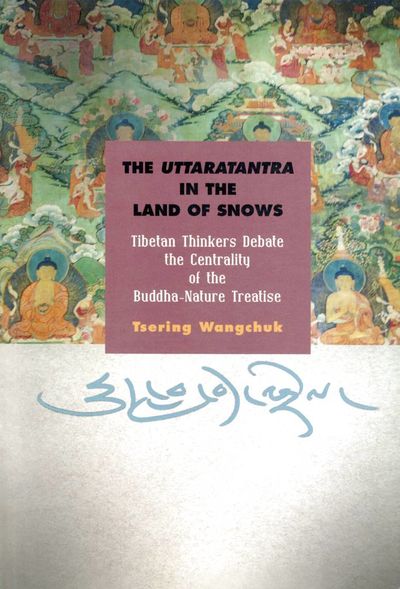The Uttaratantra in the Land of Snows
< Books
| Line 12: | Line 12: | ||
The advantage of Wangchuk's historical frame is that all assertions are placed in easy context of an opponent or supporter's writing, thus reminding the reader that buddha-nature theory in Tibet is an ongoing conversation, a debate between the two fundamental doctrinal poles of positive and negative descriptions of the ultimate. | The advantage of Wangchuk's historical frame is that all assertions are placed in easy context of an opponent or supporter's writing, thus reminding the reader that buddha-nature theory in Tibet is an ongoing conversation, a debate between the two fundamental doctrinal poles of positive and negative descriptions of the ultimate. | ||
| + | |BookToc=*{{i|Acknowledgments|}} | ||
| + | *{{i|Introduction|}} | ||
| + | |||
| + | *{{i|General Remarks|}} | ||
| + | *{{i|Textual Historical Background|}} | ||
| + | |||
| + | *{{i|Part I. Early Period: Kadam Thinkers Rescue the Treatise|}} | ||
| + | **{{i|1. Rise of the Uttaratantra in Tibet: Early Kadam Scholars Revitalize the Newly Discovered Indian Exegesis|}} | ||
| + | ***{{i|Introduction|}} | ||
| + | ***{{i|Ngok and Chapa on the Pervasive Nature of the Buddha-Body|}} | ||
| + | ***{{i|Ngok and Chapa on Definitive or Provisional Nature in the Uttaratantra |}} | ||
| + | ***{{i|Ngok and Chapa on the Uttaratantra as a Last Wheel Treatise |}} | ||
| + | ***{{i|Buddha-Element as a Conceived Object|}} | ||
| + | ***{{i|Ngok and Chapa Differ on Emphasis|}} | ||
| + | ***{{i|Conclusion|}} | ||
| + | **{{i|2. Sowing Seeds for Future Debate: Dissenters and Adherents|}} | ||
| + | ***{{i|Introduction |}} | ||
| + | ***{{i|Sapen, the Dissenter |}} | ||
| + | ***{{i|Rikrel, the Third Karmapa, and Sangpu Lodrö Defend the Uttaratantra |}} | ||
| + | ***{{i|Rinchen Yeshé’s Proto Other-Emptiness Presentation of the Uttaratantra, and Butön’s Reply|}} | ||
| + | ***{{i|Conclusion|}} | ||
| + | *{{i|Part II. The Pinnacle Period: the Other-Emptiness Interpretation Spreads |}} | ||
| + | **{{i|3. Other-Emptiness Tradition: The Uttaratantra in Dölpopa’s Works|}} | ||
| + | ***{{i|Introduction|}} | ||
| + | ***{{i|Predominance of the Last Wheel Scriptures|}} | ||
| + | ***{{i|Is the Uttaratantra a Cittamātra Text or a Madhyamaka Text?|}} | ||
| + | ***{{i|Classification of Cittamātra|}} | ||
| + | ***{{i|Classification of Madhyamaka|}} | ||
| + | ***{{i|Conclusion|}} | ||
| + | **{{i|4. The Uttaratantra in Fourteenth-Century Tibet|}} | ||
| + | ***{{i|Introduction |}} | ||
| + | ***{{i|Sazang Follows in His Master’s Footsteps|}} | ||
| + | ***{{i|Two Fourteenth-Century Kadam Masters’ Uttaratantra Commentaries |}} | ||
| + | ***{{i|Longchenpa’s View on the Uttaratantra|}} | ||
| + | ***{{i|Conclusion|}} | ||
| + | *{{i|Part III. The Argumentation Period: Self-Emptiness Proponents criticize Other-Emptiness Approach |}} | ||
| + | **{{i|5. Challenges to the Purely Definitive Nature of the Uttaratantra: Zhalu Thinkers Criticize Dölpopa |}} | ||
| + | ***{{i|Introduction|}} | ||
| + | ***{{i|Butön’s Ornament |}} | ||
| + | ***{{i|Dratsépa’s Commentary|}} | ||
| + | ***{{i|Conclusion|}} | ||
| + | **{{i|6. Challenges to the Supremacy of the Uttaratantra: Rendawa and Tsongkhapa on Tathāgata-essence Literature |}} | ||
| + | ***{{i|Introduction|}} | ||
| + | ***{{i|Rendawa on the Uttaratantra and the Tathāgata-Essence Literature|}} | ||
| + | ***{{i|Tsongkhapa on the Uttaratantra and the Tathāgata-Essence Literature|}} | ||
| + | ***{{i|Conclusion|}} | ||
| + | **7. {{i|Gyeltsap’s Commentary on the Uttaratantra: A Critique of Dölpopa’s Interpretation of Tathāgata-essence Literature|}} | ||
| + | ***{{i|Introduction|}} | ||
| + | ***{{i|Middle Wheel and Last Wheel Teachings|}} | ||
| + | ***{{i|Definitive Meaning and Provisional Meaning|}} | ||
| + | ***{{i|Self-Emptiness and Other-Emptiness|}} | ||
| + | ***{{i|Conclusion|}} | ||
| + | *{{i|Conclusion|}} | ||
| + | *{{i|General Remarks|}} | ||
| + | *{{i|Completing the Cycle|}} | ||
| + | *{{i|Notes|}} | ||
| + | *{{i|Bibliography|}} | ||
| + | *{{i|Tibetan Language Works Cited|}} | ||
| + | *{{i|English Language Works Cited|}} | ||
| + | *{{i|Index|}} | ||
|AddRelatedTab=No | |AddRelatedTab=No | ||
|QuotesTabContent={{GetBookQuotes}} | |QuotesTabContent={{GetBookQuotes}} | ||
|PostStatus=Needs Copy Editing | |PostStatus=Needs Copy Editing | ||
}} | }} | ||
Revision as of 18:23, 19 July 2018
With its emphasis on the concept of buddha-nature, or the ultimate nature of mind, the Uttaratantra is a classical Buddhist treatise that lays out an early map of the Mahāyāna path to enlightenment. Tsering Wangchuk unravels the history of this important Indic text in Tibet by examining numerous Tibetan commentaries and other exegetical texts on the treatise that emerged between the eleventh and fifteenth centuries. These commentaries explored such questions as: Is the buddha-nature teaching found in the Uttaratantra literally true, or does it have to be interpreted differently to understand its ultimate meaning? Does it explicate ultimate truth that is inherently enlightened or ultimate truth that is empty only of independent existence? Does the treatise teach ultimate nature of mind according to the Cittamātra or the Madhyamaka School of Mahāyāna? By focusing on the diverse interpretations that different textual communities employed to make sense of the Uttaratantra, Wangchuk provides a necessary historical context for the development of the text in Tibet. (Source: SUNY Press)
| Citation | Wangchuk, Tsering. The Uttaratantra in the Land of Snows: Tibetan Thinkers Debate the Centrality of the Buddha-Nature Treatise. Albany: State University of New York Press, 2017. |
|---|---|


